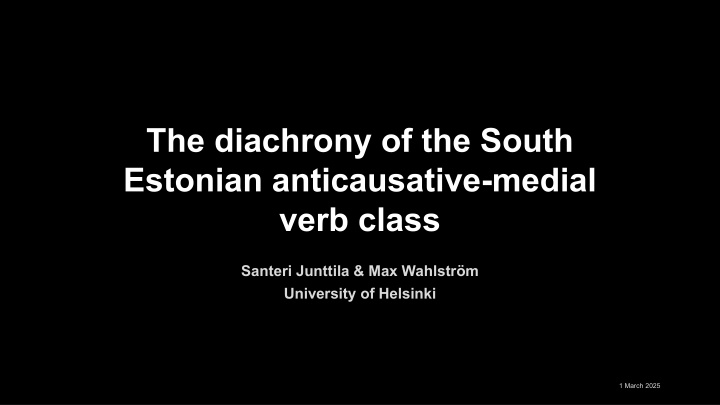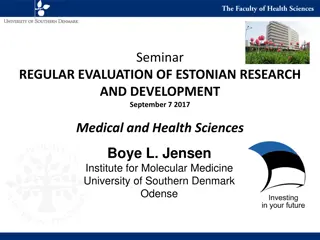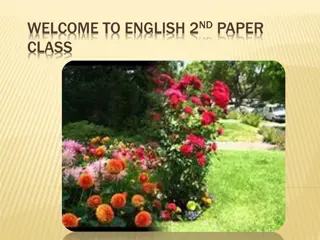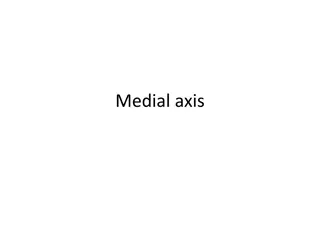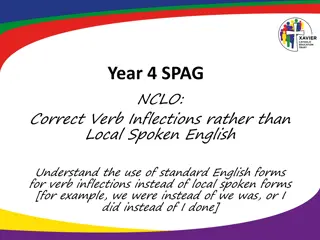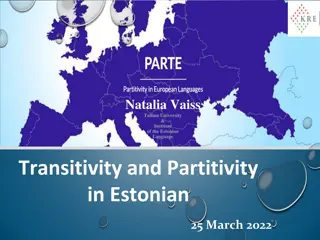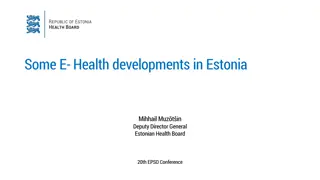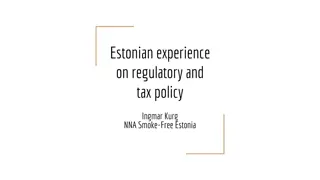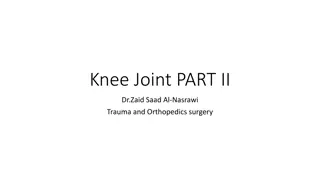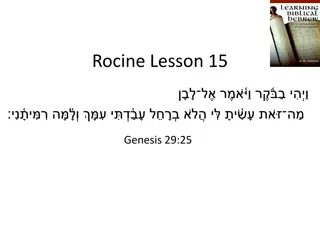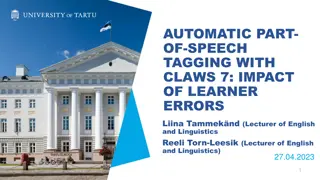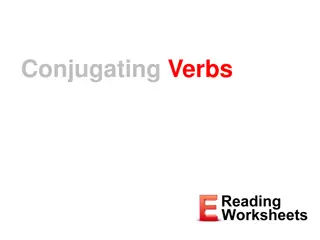The diachrony of the South Estonian anticausative-medial verb class
This study examines the evolution and usage patterns of anticausative-medial verbs in South Estonian, shedding light on its diachronic development and linguistic significance. By analyzing data from the University of Helsinki, the researchers uncover unique insights into the structural changes within this verb class over time, providing valuable contributions to the field of linguistics.
Download Presentation

Please find below an Image/Link to download the presentation.
The content on the website is provided AS IS for your information and personal use only. It may not be sold, licensed, or shared on other websites without obtaining consent from the author.If you encounter any issues during the download, it is possible that the publisher has removed the file from their server.
You are allowed to download the files provided on this website for personal or commercial use, subject to the condition that they are used lawfully. All files are the property of their respective owners.
The content on the website is provided AS IS for your information and personal use only. It may not be sold, licensed, or shared on other websites without obtaining consent from the author.
E N D
Presentation Transcript
The diachrony of the South Estonian anticausative-medial verb class Santeri Junttila & Max Wahlstr m University of Helsinki 1 March 2025
The diachrony of the South Estonian anticausative-medial verb class Introduction In South Estonian (SEst.), in the simple past tense positive, the preterite marker, expressed through the centralisation of stress (so called over-long grade or III grade) + -U- (-u- ~ - -, depending on vowel harmony), inherited from an earlier derivational suffix, has developed into a marker of valence type Non-anticausative-medial verbs previously belonging to the same inflectional class resort to other preterite markers, thus giving birth to a class, dedicated only to anticausative-medial verbs In the other Finnic languages, there are several anticausative derivative affixes, partly sharing their forms with derivative affixes of different semantics Here, we present first the diachronic development of the preterite markers and, finally, some further challenges Junttila & Wahlstr m: The diachrnoy of the South Estonian anticausative-medial verb class 1 March 2025
Historical South Estonian language area 1 March 2025 Junttila & Wahlstr m: The diachrnoy of the South Estonian anticausative-medial verb class
The variation of active positive preterite markers in South Estonian (1) palatalization of final consonant; (2) -i-; (3) centralisation of stress + -i-; (4) -E- (-e- ~ - -); (5) centralisation of stress + -E-; (6) -jjE-; (7) - ; (8) -si-; (9) -(d)sE-; and (10) centralisation of stress + -U- (-u- ~ - -). Junttila & Wahlstr m: The diachrnoy of the South Estonian anticausative-medial verb class 1 March 2025
The variation of active positive preterite markers in South Estonian Supine ol ma 1 maq 2 saq 3 t 1 miq 2 tiq 3 n lug ma el m loi loit lugi loi loit loiq read k m k s m `saama nakama `tundma p s m k ve `k sse sai k vet `k sset sait k ve `k sse `sajj k ve `k sse sai k vet `k sset sait k veq `k sseq `sajj q visit ask get olli ollit oll olli ollit olliq be `elli `ellit `elli `elli `ellit `elliq live nagasi nagasit `tunds t `p ss t naa `tunds `p ss nagasi `tunds `p ss nagasit `tunds t `p ss t nagasiq `tunds q`p ss q start feel `tunds `p ss stay Junttila & Wahlstr m: The diachrnoy of the South Estonian anticausative-medial verb class 1 March 2025
The diachrony of the variation This diversity is mostly due to post-Proto-Finnic sound changes. All these forms originate from a fusion of the verb stem and the PFi preterite marker *-j-. The forms with centralisation of stress and the ones with -jjE- developed from PFi preterites with 3rdperson reflexive suffix *-hen. These preterite classes still include many reflexive and intransitive verbs. However, the only preterite class seeming to be strictly restricted by means of valence is the one formed with centralisation of stress + -U-. We propose that this class includes exclusively anticausative and medial verbs; this hypothesis should be applied to larger South Estonian dialect corpora. Junttila & Wahlstr m: The diachrnoy of the South Estonian anticausative-medial verb class 1 March 2025
The preterite with centralisation of stress + -U- This ending goes possibly back to the PFi reflexive-medial derivational morpheme *-pU- + the preteritee marker *-j- + the 3rdperson reflexive suffix *- hen: Middle PFi *n lk -p -je- en > Late PFi *n lk - b-i-hen > > *n lk vihen > n lk hen > SEst. `n lg starved Cf. the supine `n lg m to starve ( n lg hunger < PFi *n lk ): Middle PFi *n lk -p -m - en > Late PFi *n lk -b -m -hen > *n lk m hen > Arch. SEst. n l:g m he > SEst. `n lg m (-mA- is the supine marker). Junttila & Wahlstr m: The diachrnoy of the South Estonian anticausative-medial verb class 1 March 2025
The preterite with centralisation of stress + -U- In addition to PFi *-pU-, there were reflexive-medial derivational morphemes *-UtU- and *-U-, found in SEst. `uppuma to sink (< PFi *uppo-utu-) `s nd m to be born (< PFi *s nt- -), and p s m to stay (< PFi *p s- -) etc. All verbs including these morphemes take the SEst. preterite with centralisation of stress + -U-. However, other SEst. verbs with PFi stem *-U- take another preterite forms, often with centralisation of stress anticausative-medial semantics: k s m : pret. `k sse to ask , cf. p s m : pret. `p ss to stay + -E-. These verbs don t have Junttila & Wahlstr m: The diachrnoy of the South Estonian anticausative-medial verb class 1 March 2025
The preterite with centralisation of stress + -U- We maintain that the preterite `k sse of k s m to ask is a result of regular sound changes from PFi: *k s -j-hen > *k sehen > SEst. `k sse, cf. *niitt -j-hen > SEst. `niite, illat. pl. of niit meadow On the contrary, pret. `p ss of p s m to stay and pret. `s nd from `s nd m to be born follow the analogy of pret. `n lg of `n lg m starved The limits of the analogical spread of this preterite class seem to be conditioned to the automativity / mediality of the verbs and a presence of a PFi component -U-. Junttila & Wahlstr m: The diachrnoy of the South Estonian anticausative-medial verb class 1 March 2025
Choice of preterite class conditioned by valence The limits of the analogical spread of this preterite class seem to be conditioned by the anticausativity / mediality of the verbs and a presence of a component -U-. `l pma, pret. `l ppu to die, to end `murduma, pret. `murdu to break into pieces `tahtuma, pret. `tahtu to appear to someone as a wish un htuma, pret. un htu to be forgotten habrastuma, pret. habrastu to grow mouldy Junttila & Wahlstr m: The diachrnoy of the South Estonian anticausative-medial verb class 1 March 2025
Choice of preterite class conditioned by valence Verbs with no anticausativity / mediality mostly retain historically regular preterite forms: `haukma, pret. hauk to bark `kirsuma, pret. kir to scream `kutsma, pret. kut to invite ~ pret. `kuts `kiskma, pret. kisk to pull < PFi *haukku-ma- : *haukku-j (onom.) < PFi *kirsahu-ma- : *kirsahu-j (onom.) < PFi *ku u-ma- : *ku u-j ( Baltic) < PFi *ku u-j-hen < PFi *kisko-ma- : *kisko-j (o > u after a long syllable) Junttila & Wahlstr m: The diachrnoy of the South Estonian anticausative-medial verb class 1 March 2025
Choice of preterite class conditioned by valence Some verbs with PFi continuative-frequentative -U- make up a transitional category, having both a historically regular preterite and an analogical one: `tsilkma, pret. `tsilk to drop < PFi *cilkku-ma- : *cilkku-j-hen ~ pret. `tsilku `liikma, pret. `liik to move < PFi *liikku-ma- : *liikku-j-hen ~ pret. `liiku `istma, pret. `ist to sit ~ pret. `istu However, all these cases do not have an analogical parallel: `astma, pret. `ast to step, go < PFi *istu-ma- : *istu-j-hen < PFi *astu-ma- : *astu-j-hen Junttila & Wahlstr m: The diachrnoy of the South Estonian anticausative-medial verb class 1 March 2025
Choice of preterite class conditioned by valence Some verbs with PFi continuative-frequentative -U- make up a transitional category, having both a historically regular preterite and an analogical one: `tsilkma, pret. `tsilk (~ `tsilke) to drop, ooze k ll mul ` kva p `tsilke my head was really oozing (sweat) (transitive-like) ~ pret. tsilku `tetti tuu kost `tsilku that (hole) was made whence (the birch sap) dropped (intransitive) `istma, pret. `ist to sit tem ol `m isnik tem ju `ist he was the estate owner (so) he was sitting (stative) ~ pret. `istu ka nii maha `istu and so I sat down (medial / reflexive) Junttila & Wahlstr m: The diachrnoy of the South Estonian anticausative-medial verb class 1 March 2025
Tehns kullamast! Thank you for your attention! 1 March 2025 Junttila & Wahlstr m: The diachrnoy of the South Estonian anticausative-medial verb class
